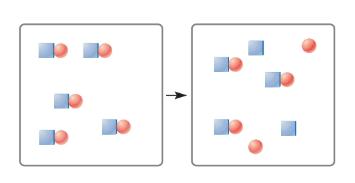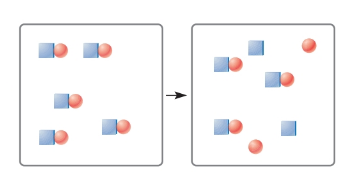
Chemistry: Principles and Reactions
8th Edition
ISBN: 9781305079373
Author: William L. Masterton, Cecile N. Hurley
Publisher: Cengage Learning
expand_more
expand_more
format_list_bulleted
Concept explainers
Textbook Question
Chapter 4, Problem 68QAP
The following figures represent species before and after they are dissolved in water. Classify each species as weak electrolyte, strong electrolyte, or nonelectrolyte. You may assume that species that dissociate during solution break up as ions.


Expert Solution & Answer
Want to see the full answer?
Check out a sample textbook solution
Students have asked these similar questions
An electrode process takes place at a metal-solution interface. Indicate the current condition that must be met for Faradaic rectification to occur.
At a metal-solution interface, an electron is exchanged, and the symmetry factor beta < 0.5 is found in the Butler-Volmer equation. What does this indicate?
Topic: Photochemistry and Photophysics of Supramolecules
Chapter 4 Solutions
Chemistry: Principles and Reactions
Ch. 4 - Write the formulas of the following compounds and...Ch. 4 - Prob. 2QAPCh. 4 - Describe how you would precipitate (a) zinc...Ch. 4 - Name the reagent, if any, that you would add to a...Ch. 4 - Write net ionic equations for the formation of (a)...Ch. 4 - Write net ionic equations to explain the formation...Ch. 4 - Decide whether a precipitate will form when the...Ch. 4 - Follow the directions of Question 7 for solutions...Ch. 4 - Write a net ionic equation for any precipitation...Ch. 4 - Follow the directions for Question 9 for the...
Ch. 4 - What volume of 0.2500 M cobalt(III) sulfate is...Ch. 4 - Prob. 12QAPCh. 4 - A 50.00-mL sample of 0.0250 M silver nitrate is...Ch. 4 - Aluminum ions react with carbonate ions to form an...Ch. 4 - When Na3PO4 and Ca(NO3)2 are combined, the...Ch. 4 - When solutions of aluminum sulfate and sodium...Ch. 4 - Prob. 17QAPCh. 4 - Prob. 18QAPCh. 4 - Prob. 19QAPCh. 4 - Follow the directions of Question 19 for the...Ch. 4 - For an acid-base reaction, what is the reacting...Ch. 4 - Follow the directions of Question 21 for the...Ch. 4 - Prob. 23QAPCh. 4 - Prob. 24QAPCh. 4 - Consider the following generic equation: H+(aq)+...Ch. 4 - Consider the following generic equation...Ch. 4 - Prob. 27QAPCh. 4 - Prob. 28QAPCh. 4 - Prob. 29QAPCh. 4 - Consider several 25.00-mL solutions of perchloric...Ch. 4 - Prob. 31QAPCh. 4 - A student tries to determine experimentally the...Ch. 4 - Prob. 33QAPCh. 4 - For a product to be called vinegar, it must...Ch. 4 - The percentage of sodium hydrogen carbonate,...Ch. 4 - Prob. 36QAPCh. 4 - An artificial fruit beverage contains 12.0 g of...Ch. 4 - Lactic acid, C3H6O3 is the acid present in sour...Ch. 4 - Prob. 39QAPCh. 4 - Prob. 40QAPCh. 4 - Assign oxidation numbers to each element in (a)...Ch. 4 - Assign oxidation numbers to each element in (a)...Ch. 4 - Classify each of the following half-reactions as...Ch. 4 - Classify each of the following half-reactions as...Ch. 4 - Classify each of the following half-reactions as...Ch. 4 - Prob. 46QAPCh. 4 - For each unbalanced equation given below • write...Ch. 4 - Prob. 48QAPCh. 4 - A solution of potassium permanganate reacts with...Ch. 4 - Prob. 50QAPCh. 4 - Hydrogen gas is bubbled into a solution of barium...Ch. 4 - Consider the reaction tween silver and nitric acid...Ch. 4 - The molarity of iodine in solution can be...Ch. 4 - A wire weighing 0.250 g and containing 92.50% Fe...Ch. 4 - Glycerol (C3H8O3) is commonly used as an additive...Ch. 4 - Laws passed in some states define a drunk driver...Ch. 4 - A sample of limestone weighing 1.005 g is...Ch. 4 - The iron content of hemoglobin is determined by...Ch. 4 - In order to determine the purity of ammonium...Ch. 4 - Gold metal will dissolve only in aqua regia, a...Ch. 4 - Prob. 61QAPCh. 4 - Ten mL of concentrated H3PO4 (91.7% by mass,...Ch. 4 - Consider the following balanced redox reaction in...Ch. 4 - Prob. 64QAPCh. 4 - Using circles to represent cations and squares to...Ch. 4 - Assuming that circles represent cations and...Ch. 4 - Consider four beakers. Beaker A has an aqueous...Ch. 4 - The following figures represent species before and...Ch. 4 - A student is asked to identify the metal nitrate...Ch. 4 - Three students titrate different samples of the...Ch. 4 - Calcium in blood or urine can be determined by...Ch. 4 - Copper metal can reduce silver ions to metallic...Ch. 4 - Copper metal can reduce silver ions to metallic...Ch. 4 - A solution contains both iron(II) and iron(III)...Ch. 4 - A student is given 0.930 g of an unknown acid,...Ch. 4 - Solid iron(III) hydroxide is added to 625 mL of...Ch. 4 - A 300.0-g sample of a solid is made up of a...Ch. 4 - When 85.0 mL of 0.250 M Ba(OH)2 solution is added...
Knowledge Booster
Learn more about
Need a deep-dive on the concept behind this application? Look no further. Learn more about this topic, chemistry and related others by exploring similar questions and additional content below.Similar questions
- When two solutions, one of 0.1 M KCl (I) and the other of 0.1 M MCl (II), are brought into contact by a membrane. The cation M cannot cross the membrane. At equilibrium, x moles of K+ will have passed from solution (I) to (II). To maintain the neutrality of the two solutions, x moles of Cl- will also have to pass from I to II. Explain this equality: (0.1 - x)/x = (0.1 + x)/(0.1 - x)arrow_forwardCalculate the variation in the potential of the Pt/MnO4-, Mn2+ pair with pH, indicating the value of the standard potential. Data: E0 = 1.12.arrow_forwardGiven the cell: Pt l H2(g) l dis X:KCl (sat) l Hg2Cl2(s) l Hg l Pt. Calculate the emf of the cell as a function of pH.arrow_forward
- The decimolar calomel electrode has a potential of 0.3335 V at 25°C compared to the standard hydrogen electrode. If the standard reduction potential of Hg22+ is 0.7973 V and the solubility product of Hg2Cl2 is 1.2x 10-18, find the activity of the chlorine ion at this electrode.Data: R = 8.314 J K-1 mol-1, F = 96485 C mol-1, T = 298.15 K.arrow_forward2. Add the following group of numbers using the correct number of significant figures for the answer. Show work to earn full credit such as rounding off the answer to the correct number of significant figures. Replace the question marks with the calculated answers or write the calculated answers near the question marks. 10916.345 37.40832 5.4043 3.94 + 0.0426 ? (7 significant figures)arrow_forwardThe emf at 25°C of the cell: Pt l H2(g) l dis X:KCl (sat) l Hg2Cl2(s) l Hg l Pt was 612 mV. When solution X was replaced by normal phosphate buffer solution with a pH of 6.86, the emf was 741 mV. Calculate the pH of solution X.arrow_forward
- Indicate how to calculate the potential E of the reaction Hg2Cl2(s) + 2e ⇄ 2Hg + 2Cl- as a function of the concentration of Cl- ions. Data: the solubility product of Hg2Cl2.arrow_forwardHow can Beer’s Law be used to determine the concentration in a selected food sample. Provide an in-depth discussion and examples of this.arrow_forwardb) H3C- H3C Me CH 3 I HN Me H+arrow_forward
arrow_back_ios
SEE MORE QUESTIONS
arrow_forward_ios
Recommended textbooks for you
 Introductory Chemistry: An Active Learning Approa...ChemistryISBN:9781305079250Author:Mark S. Cracolice, Ed PetersPublisher:Cengage Learning
Introductory Chemistry: An Active Learning Approa...ChemistryISBN:9781305079250Author:Mark S. Cracolice, Ed PetersPublisher:Cengage Learning Chemistry: Principles and ReactionsChemistryISBN:9781305079373Author:William L. Masterton, Cecile N. HurleyPublisher:Cengage Learning
Chemistry: Principles and ReactionsChemistryISBN:9781305079373Author:William L. Masterton, Cecile N. HurleyPublisher:Cengage Learning World of Chemistry, 3rd editionChemistryISBN:9781133109655Author:Steven S. Zumdahl, Susan L. Zumdahl, Donald J. DeCostePublisher:Brooks / Cole / Cengage Learning
World of Chemistry, 3rd editionChemistryISBN:9781133109655Author:Steven S. Zumdahl, Susan L. Zumdahl, Donald J. DeCostePublisher:Brooks / Cole / Cengage Learning Introductory Chemistry: A FoundationChemistryISBN:9781337399425Author:Steven S. Zumdahl, Donald J. DeCostePublisher:Cengage LearningChemistry: Matter and ChangeChemistryISBN:9780078746376Author:Dinah Zike, Laurel Dingrando, Nicholas Hainen, Cheryl WistromPublisher:Glencoe/McGraw-Hill School Pub Co
Introductory Chemistry: A FoundationChemistryISBN:9781337399425Author:Steven S. Zumdahl, Donald J. DeCostePublisher:Cengage LearningChemistry: Matter and ChangeChemistryISBN:9780078746376Author:Dinah Zike, Laurel Dingrando, Nicholas Hainen, Cheryl WistromPublisher:Glencoe/McGraw-Hill School Pub Co Principles of Modern ChemistryChemistryISBN:9781305079113Author:David W. Oxtoby, H. Pat Gillis, Laurie J. ButlerPublisher:Cengage Learning
Principles of Modern ChemistryChemistryISBN:9781305079113Author:David W. Oxtoby, H. Pat Gillis, Laurie J. ButlerPublisher:Cengage Learning

Introductory Chemistry: An Active Learning Approa...
Chemistry
ISBN:9781305079250
Author:Mark S. Cracolice, Ed Peters
Publisher:Cengage Learning

Chemistry: Principles and Reactions
Chemistry
ISBN:9781305079373
Author:William L. Masterton, Cecile N. Hurley
Publisher:Cengage Learning

World of Chemistry, 3rd edition
Chemistry
ISBN:9781133109655
Author:Steven S. Zumdahl, Susan L. Zumdahl, Donald J. DeCoste
Publisher:Brooks / Cole / Cengage Learning

Introductory Chemistry: A Foundation
Chemistry
ISBN:9781337399425
Author:Steven S. Zumdahl, Donald J. DeCoste
Publisher:Cengage Learning

Chemistry: Matter and Change
Chemistry
ISBN:9780078746376
Author:Dinah Zike, Laurel Dingrando, Nicholas Hainen, Cheryl Wistrom
Publisher:Glencoe/McGraw-Hill School Pub Co

Principles of Modern Chemistry
Chemistry
ISBN:9781305079113
Author:David W. Oxtoby, H. Pat Gillis, Laurie J. Butler
Publisher:Cengage Learning
Solutions: Crash Course Chemistry #27; Author: Crash Course;https://www.youtube.com/watch?v=9h2f1Bjr0p4;License: Standard YouTube License, CC-BY